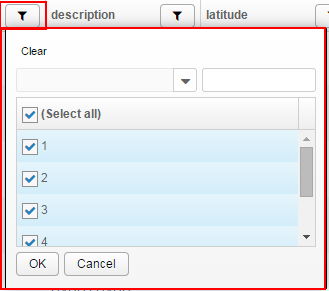Creating a custom reusable filtering interface with macro component: An Example"
m |
m (→User Interface) |
||
| Line 33: | Line 33: | ||
FilterConfig macro component can be inserted in the list header. It requires a '''FilterModel''' object to keep track of the current filter configuration in the dialog. The component will also notify the application when filter configuration changes or clears. | FilterConfig macro component can be inserted in the list header. It requires a '''FilterModel''' object to keep track of the current filter configuration in the dialog. The component will also notify the application when filter configuration changes or clears. | ||
| − | <source lang="xml"> | + | <source lang="xml" highlight="2"> |
<listheader> | <listheader> | ||
<filterConfig | <filterConfig | ||
Revision as of 07:26, 26 February 2015
Neil Lee, Engineer, Potix Corporation
March xx, 2015
ZK 7.0.4
Introduction
Filtering commonly augments data displaying functionality. Users can create multiple views of a single data set based on different filter criteria. As data sets become larger and larger, filtering also helps increase performance and improve usability by reducing the information shown.
Application authors would need to design an user interface to allow users to select their filtering preferences. Take Excel for example. After filtering is enabled, each column header will include a button, such that when clicked, displays the filtering configuration dialog box for the respective column. Users can then edit the condition that the data in that column must satisfy in order to be included in the final display.
In this smalltalk, I created an Excel-like user interface for collecting filtering criteria. The gathered information is then used in the application to perform the actual filtering operation. For simplicity, I assume the original dataset is small enough to fit into memory entirely, and provide a sample implementation for in-memory filtering.
Live Demo
As an example, law enforcement agencies can use filtering to find trends in criminal activities. For concreteness, criminal records were taken from Sacramento in 2006 [1], which consists of 7,584 offenses. It is also interesting to mark illegal occurrences on google maps.
Please watch the video below to see the application in action.
How it works
In the demo, I use a listbox to display the criminal records in a table. Each column heading contains a button with a filter icon. That button, together with the popup dialog box, is encapsulated into a macro component called FilterConfig (see the image below). This dialog box allows the user to create a filter rule (e.g. contains, begins with, less than, ...) with its associated parameter, or to choose values from an optional distinct values set. The user could also remove the filter rule for the corresponding column. Moreover, the dialog box comes with two custom events for an application to handle filter application and removal.
User Interface
FilterConfig macro component can be inserted in the list header. It requires a FilterModel object to keep track of the current filter configuration in the dialog. The component will also notify the application when filter configuration changes or clears.
<listheader>
<filterConfig
model="..."
onFilterChanged="..."
onFilterCleared="...".../>
</listheader>
The macro component provides a default template for filter config user interface. Developers can also define their own template, and specify it via popupTemplate argument.
<template name="custom">
...
</template>
...
<filterConfig
popupTemplate="custom" .../>
Application
- retrieves available filter models from a service
- renders filter component based on the filter models retrieved
- listens to onFilterChanged and onFilterCleared events
- calls service to filter data based on user choices
- replace listmodel items to update the UI
Service
(keep brief, provide memory implementation, it should be easy to create database queries based on filter configuration)
- provides available filter options
- filter data based on filter configuration
Summary
Download
References
- ↑ Data source: spatialkey sample
Comments
| Copyright © Potix Corporation. This article is licensed under GNU Free Documentation License. |
